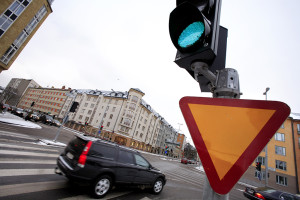Neither traffic signs nor traffic signals may be necessary if all vehicles are self-driving. But many questions remain as to what will be required in the future, which is why the Swedish National Road and Transport Research Institute (VTI), Linköping University (LiU), and the Royal Institute of Technology (KTH) are launching a project involving two doctoral candidates who will be considering a host of issues.
In this newly launched project, VTI, LiU, and KTH will review current traffic models to make sure that they can cope with the traffic systems of tomorrow, which will include partly and completely self-driving vehicles. How will the capacities of our roads and intersections be affected when some of the vehicles are self-driving? Will “drivers” of self-driving vehicles choose different routes that are tailored for self-driving vehicles even if doing so might make their trips longer?
“We want to see what demands self-driving vehicles impose on the actual traffic models. We will proceed based on the existing research, gather it all together, and see what will be required of the models of the future, before that future arrives”, says Johan Olstam.
New models are needed
Current traffic models are part of a long tradition and are based on the actions of human drivers. Those same models probably cannot be applied to self-driving vehicles, as there is much to indicate that they cannot be modelled in the same way. Modelling automated traffic systems using current modelling approaches requires sweeping simplifications and assumptions. The analyses performed to date are also fraught with major uncertainties.
“There is a strong need to determine what changes are needed in the underlying driver models to ensure correct modelling of the interaction between manually driven and self-driving vehicles, and vice versa”, says Olstam.
Information flowing into the car
Self-driving vehicles also make new ways of controlling traffic possible. If 100% of the vehicle fleet is self-driving, it is possible, for example, to develop and apply new ways of automatically controlling the traffic at on-ramps and intersections. Such traffic system automation will probably be built into the vehicle.
“One might think that this could never fully become reality, but it may be that certain roads will be designed entirely on the basis of self-driving vehicles”, says Olstam.
We are moving toward an ecosystem of interconnected and increasingly self-driven vehicles, which is creating new opportunities and challenges and in which it is becoming increasingly important to be able to model, simulate, and predict the effects of changes.
The trend toward self-driving vehicles also goes hand in hand with the trend toward digitalisation and shared ownership. How will travel change if we move toward fleets of self-driving vehicles, and if the travellers do not even own their cars?
Doctoral project underway
The results must ensure that models exist to meet the needs of the traffic system of the future, and that the models are used to perform analyses effectively. Maintaining competence is also important, and engaging two doctoral candidates is a step in that direction.
“Quite simply, people are needed who know the field, and I hope and believe that this is the first of a host of doctoral projects concerning traffic modelling for self-driving vehicles”, Olstam says.
It is not self-evident that self-driving vehicles will be the most efficient vehicles in every situation. For example, Olstam notes that city traffic could become extremely slow if both pedestrians and cyclists must be taken into account.
“It’s easier on bigger roads to start with. A self-driving vehicle has to function safely, and in cities there is a risk of slow traffic from the constant avoidance of collisions”.
Reduced environmental impact
Automating the traffic system entails a paradigm shift, with an altered driver role and the integration of vehicles and infrastructure. Automation is consequently expected to contribute to improved traffic safety in that the driver’s participation in the operational driving of the vehicle will decrease. It is also hoped that reduced environmental impact and improved energy efficiency can be achieved through more efficient vehicle driving.
VTI is heading up the project, which includes the organisations in the Centre for Traffic Research, Linköping University, and the Royal Institute of Technology.
The project, which will run until the end of September 2019, is funded by the Swedish Transport Administration and has a total budget of SEK 6.3 million.
 Contact: Contact:Johan Olstam, Researcher johan.olstam@vti.se VTI, Sweden |







Follow us: